How Many Animals Were Affected By The Bp Oil Spill
A contempo Endangered Species Research special effect summarizes some of the devastating longterm effects of the Deepwater Horizon oil spill on protected marine mammals and bounding main turtles. The upshot compiles 20 scientific studies authored by NOAA scientists and partners covering more than five years' worth of data collection, analysis, and interpretation. The research indicates that populations of several marine mammal and sea turtle species will take decades to rebound. Significant habitat restoration in the region will also exist needed.
NOAA scientists used a variety of cutting-edge research methods in these studies and many others as role of a Natural Resource Damage Assessment. This is the legal procedure where we investigate the blazon of injuries caused past the oil spill, quantify how many animals were harmed, develop a restoration program to compensate for the natural resource injuries, and hold responsible parties liable to pay for the restoration.
1. The largest offshore oil spill in U.S. history
Equally the largest offshore oil spill in U.S. history, the Deepwater Horizon oil spill released 134 one thousand thousand gallons of oil into the Gulf of Mexico over a flow of 87 days, fouling 1,300 miles of shoreline forth five states. The scientists ended that the Deepwater Horizon oil spill killed thousands of marine mammals and sea turtles, and contaminated their habitats.
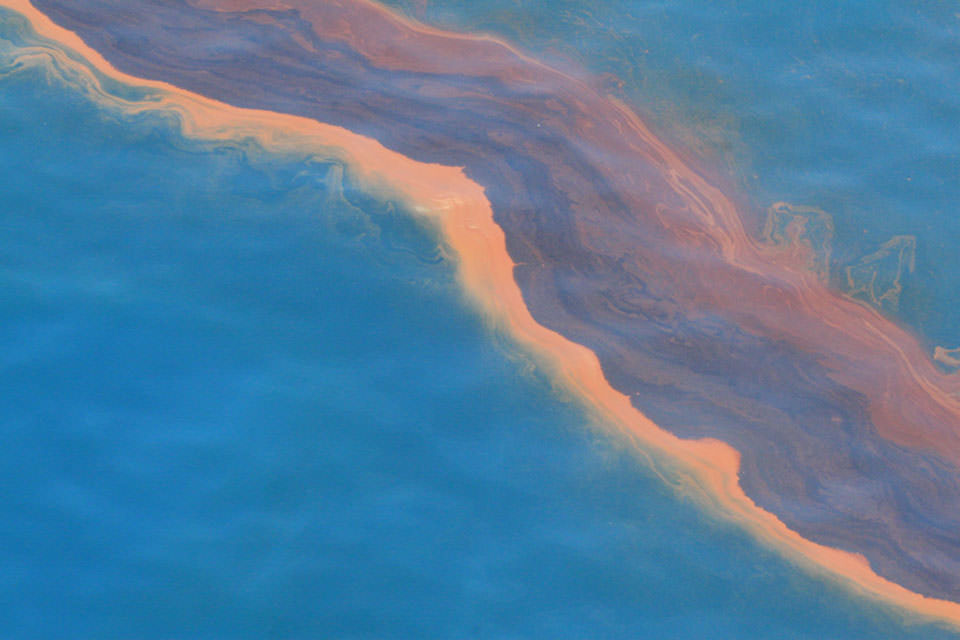
Heavy band of oil seen during an overflight on May 12, 2010. Download
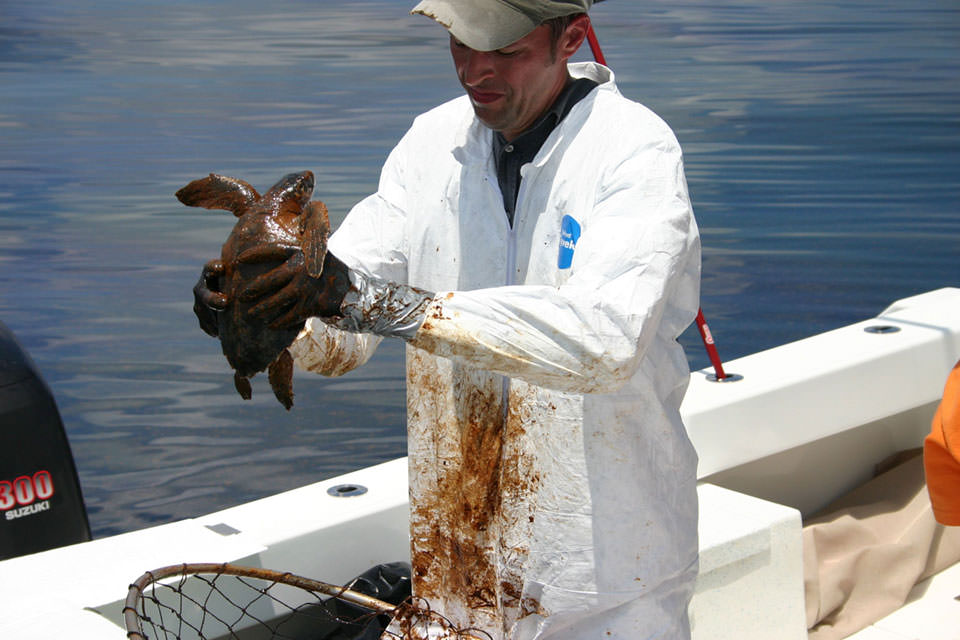
Dr. Brian Stacy, NOAA veterinarian, prepares to clean an oiled Kemp's ridley turtle. Veterinarians and scientists from NOAA, the Florida Fish and Wild fauna Commission, and other partners working under the Unified Command captured heavily-oiled young turtles xx to 40 miles offshore as part of ongoing animate being rescue and rehabilitation efforts. Credit: NOAA and Georgia Section of Natural Resources. Download
ii. Thousands of protected species were exposed to oil throughout their habitats
The northern Gulf of Mexico is domicile to 22 species of marine mammals, including manatees in coastal seagrasses and dolphins and whales in estuarine, nearshore, and offshore habitats.
V species of ocean turtles alive in the Gulf of Mexico: loggerhead, Kemp'due south ridley, greenish turtle, hawksbill, and leatherback. All of these species are protected under the Endangered Species Act. The Gulf of United mexican states provides critically of import habitats for sea turtle reproduction, feeding, migration, and refuge, including extensive Sargassum habitat in the open ocean that small juvenile turtles depend on for survival.
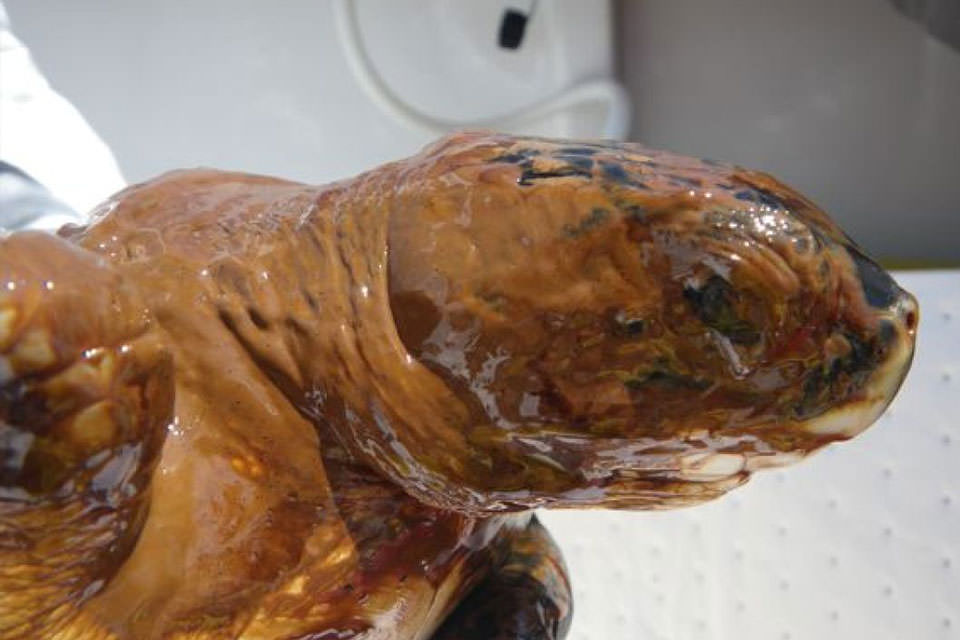
Oiled Turtle. Close-up of an oiled Kemp's ridley turtle captured during a June 1, 2010 survey. The turtle was cleaned, provided veterinary intendance, and taken to the Audubon Aquarium. Efforts continued throughout the duration of the spill to appraise the condition of these endangered bounding main turtles and to capture turtles defenseless in heavy oil. Download
The scientists determined that four species of sea turtles (Kemp's ridley, loggerhead, green turtle, and hawksbill) and their habitats were exposed to Deepwater Horizon oil in the open sea, across the continental shelf, and into nearshore and coastal areas, including beaches. A fifth species, the leatherback, was likely exposed to Deepwater Horizon oil, and some exposed leatherbacks likely died.
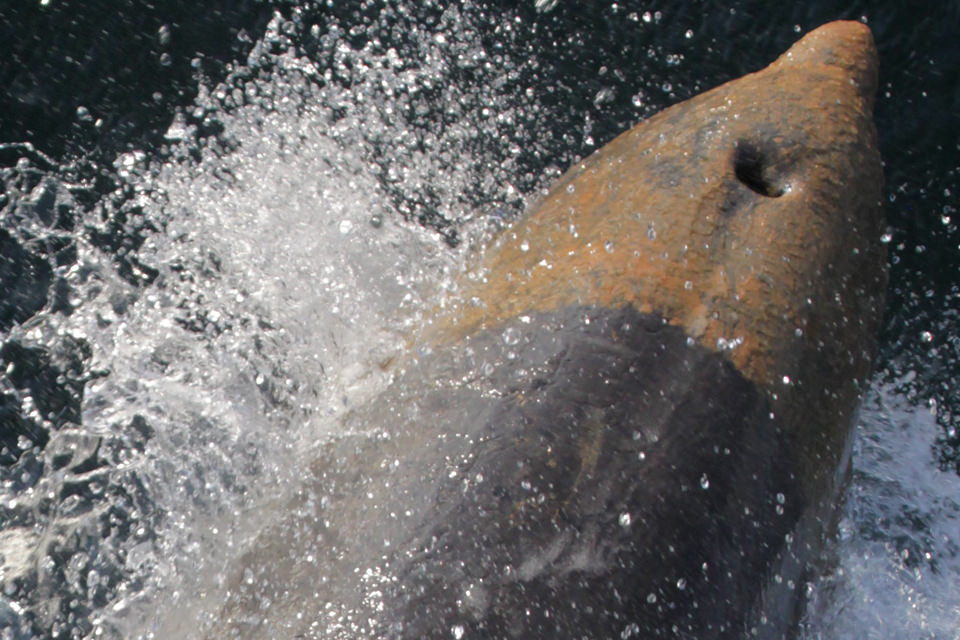
Bottlenose dolphin with oil adhered to the head, July 2010. The oil spill contaminated prime number marine mammal habitat in the estuarine, nearshore, and offshore waters of the northern Gulf of Mexico. Photo taken nether research permit. Download
Deepwater Horizon oil contaminated every blazon of habitat that northern Gulf of Mexico marine mammals occupy.
3. We investigated the types of injuries
To determine the types of injuries to whales and dolphins due to the spill, the scientists collected a diverseness of information, including field studies, stranded carcasses, historical data on marine mammal populations, and toxicity testing studies.
Marine mammals and sea turtles may accept been exposed to the oil by inhalation, aspiration, ingesting contaminated sediment, water, or prey, or past absorbing contaminants through their skin.
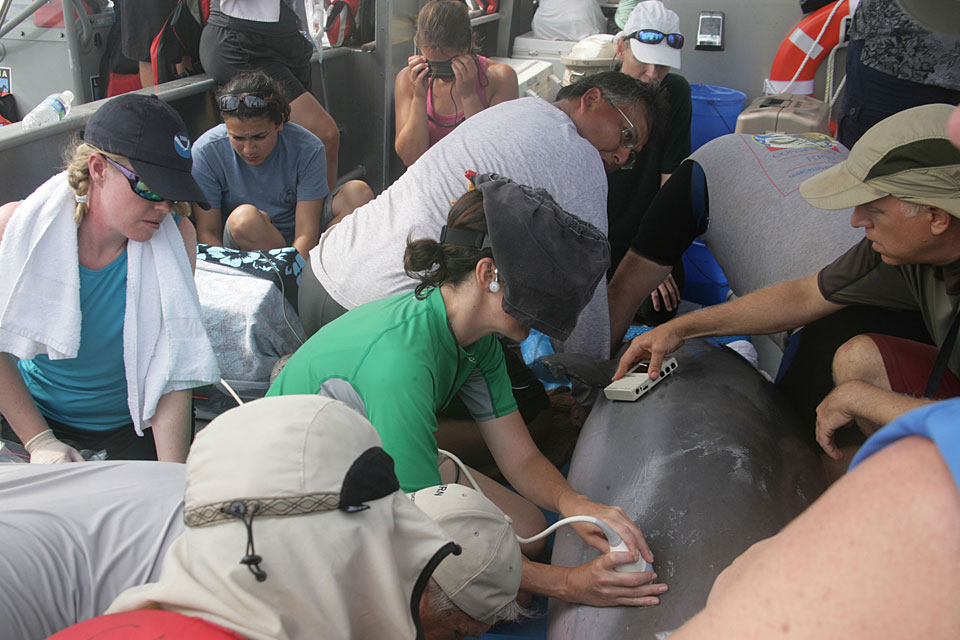
A veterinarian performs an ultrasound to assess a Barataria Bay dolphin'southward wellness in Aug. 2011. Every bit shortly as the examination was complete, the dolphin was returned to the h2o. Photograph taken nether research let. Download
Marine mammal researchers ended that exposure to the oil caused a wide range of adverse health effects such as reproductive failure and organ impairment, and that animals killed by these agin effects contributed to the largest and longest marine mammal unusual bloodshed event ever recorded in the Gulf of United mexican states.
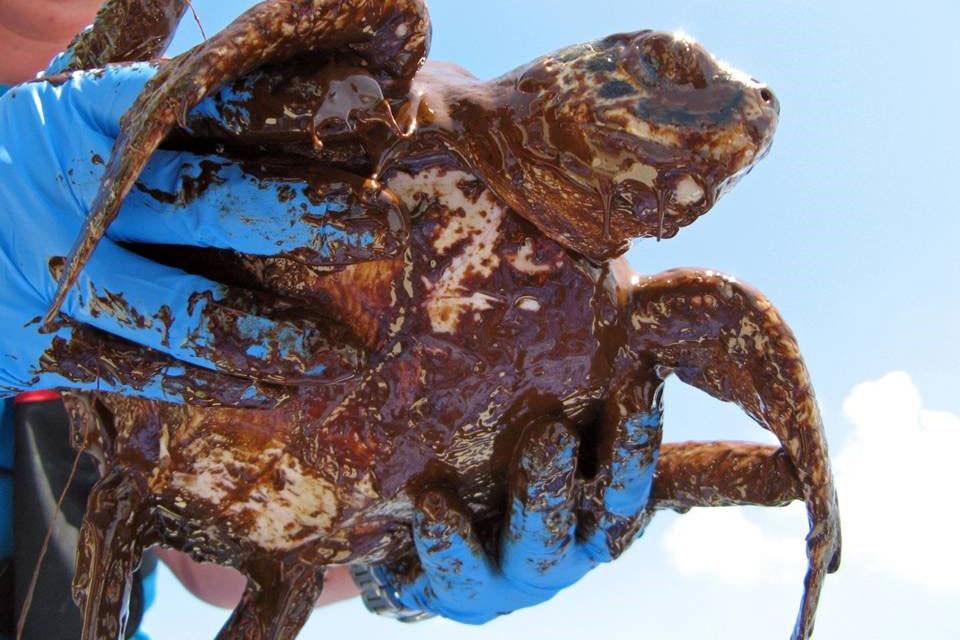
Juvenile Kemp'south ridley sea turtle oiled in the Deepwater Horizon spill in 2010. Photograph Credit: Blair Witherington, Florida Fish and Wildlife Conservation Commission Download
Miring in oil and exposure to oiled surface habitat caused significant harm to ocean turtles, including decreased mobility, exhaustion, dehydration, overheating, probable decreased ability to feed and evade predators, and death.
4. We quantified how many animals were harmed
Examples of impacts to species included: upward to 20 percent of all oceanic juvenile Kemp's Ridley sea turtles present during the Deepwater Horizon oil spill perished from oil exposure; and oil-associated wellness effects to Barataria Bay, Louisiana, bottlenosed dolphins reduced their survival and reproductive success in years post-obit the spill, leading to a 50 percent decline in the population, co-ordinate to NOAA scientists and partners.
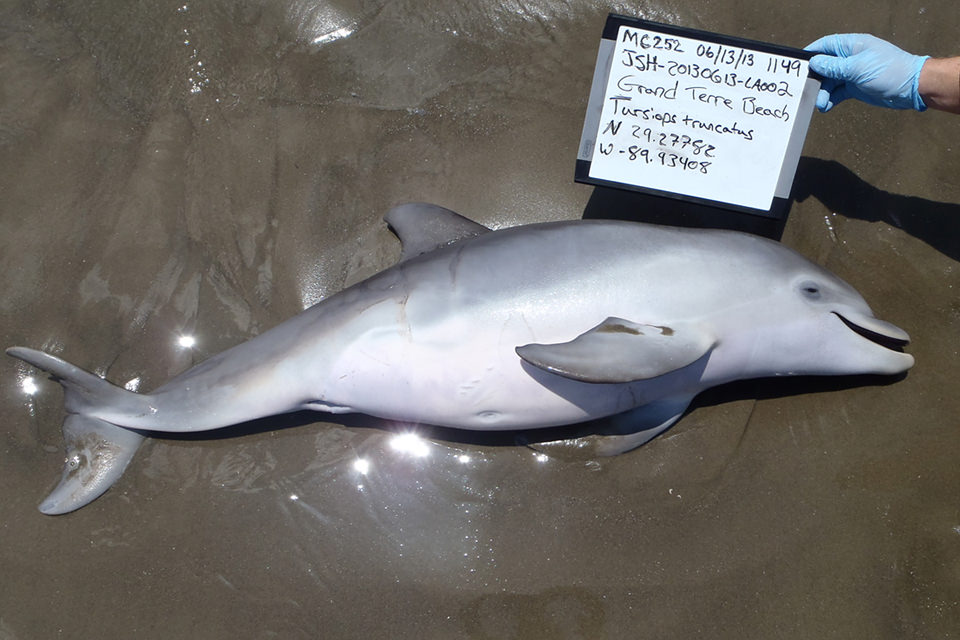
Dead bottlenose dolphin calf stranded on Grande Island, Louisiana, in 2013. At that place was an increase in dolphin strandings in the northern Gulf of Mexico for several years following the Deepwater Horizon spill. Findings from the dead animals supported prove of decreased survival and reproductive rates found in live animal studies. Credit: Louisiana Department of Wildlife and Fisheries Download
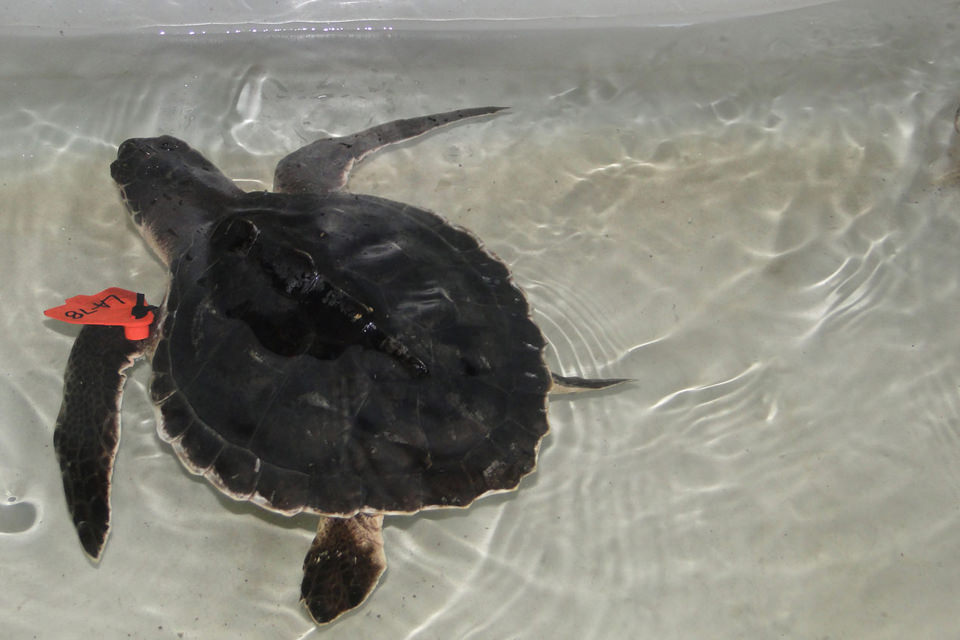
Kemp's ridely turtle after cleaning and treatment. Distressed and oiled turtles recuperated at the Audubon Nature Constitute during the spill in 2010. Download
5. We planned the restoration
Findings from these research studies, in addition to other studies on other parts of the ecosystem, formed the basis of the natural resources damage assessment settlement with BP for up to $8.eight billion for restoration projects.
Because marine mammals face a broad range of threats, a portfolio of restoration approaches include: decreasing and mitigating interactions with commercial and recreational line-fishing gear, characterizing and reducing impacts from racket, reducing illegal feeding and harassment, and increasing understanding of causes of marine mammal illness and death.
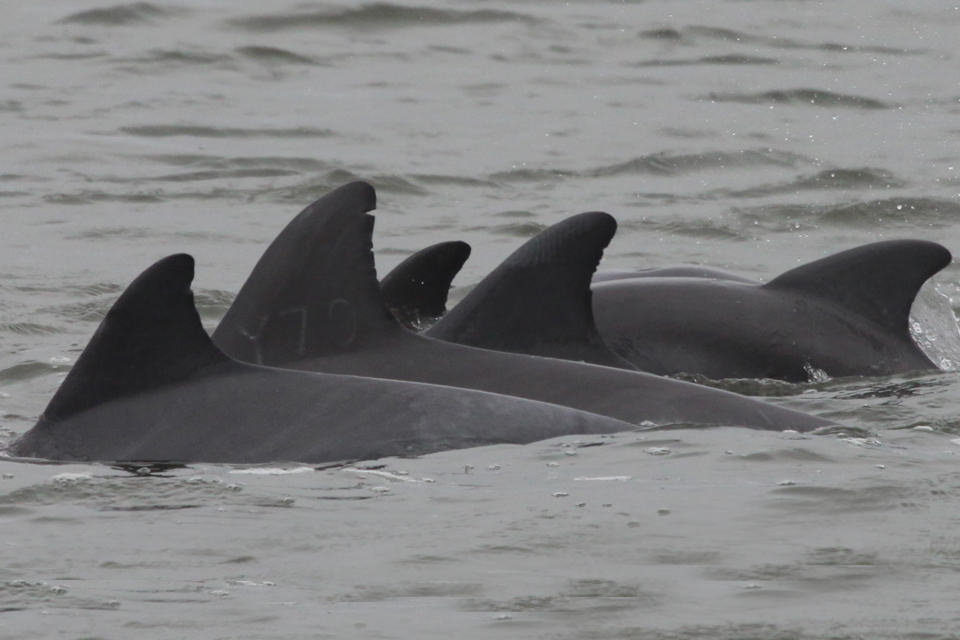
A group of dolphins photographed in May 2015 during monitoring surveys in Barataria Bay, Louisiana. The faint markings on 2nd fin indicate the dolphin is "Y79", a subadult female dolphin that had been temporarily captured for health assessment the prior year. Photograph taken under research permit. Download
Specific activities for sea turtles could include reducing fisheries bycatch, enhancing bounding main turtle stranding response and mortality investigation, and improving nesting habitat by protecting nests and reducing artificial sources of calorie-free that tin can disorient hatchlings at night.
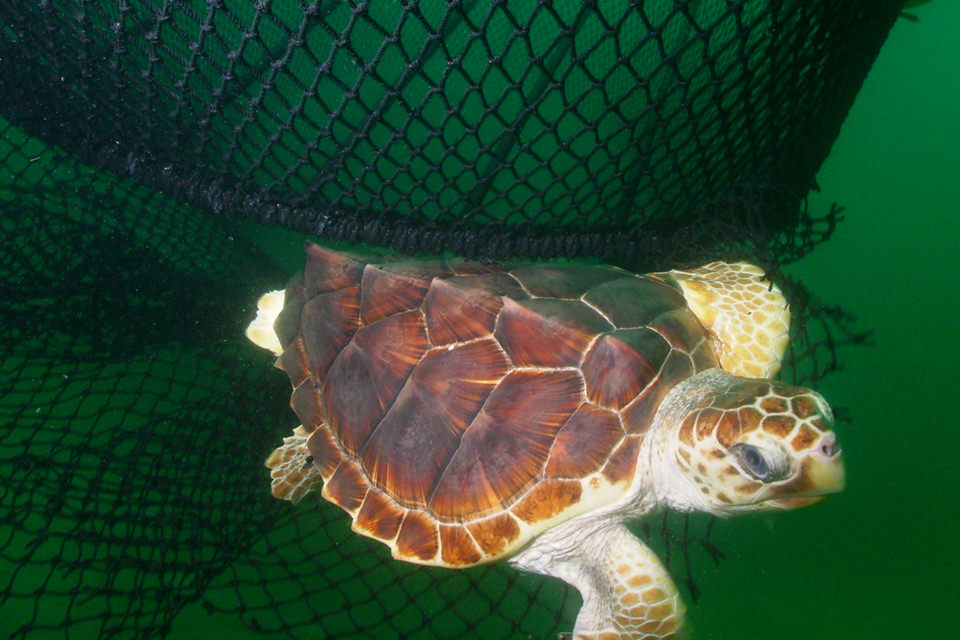
Turtle excluder devices on nets let sea turtles to escape unharmed. Restoration activities could include promoting the apply of such devices. Download
Source: https://oceanservice.noaa.gov/news/apr17/dwh-protected-species.html
Posted by: youngtwored.blogspot.com

0 Response to "How Many Animals Were Affected By The Bp Oil Spill"
Post a Comment